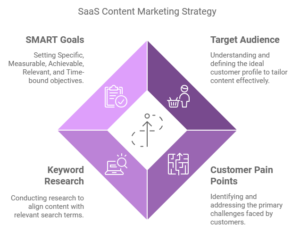Content Marketing in the SaaS Sector: Strategies for Success

Selling SaaS isn’t an average lemonade stand. It involves entire organizations, long decision cycles, and plenty of questions. Content marketing acts as the trusty guide, leading potential customers through the labyrinth of curiosity to the finish line: a sale. The challenge? Breaking down complex jargon into bite-sized, relatable nuggets while addressing customer concerns and making it sound interesting. Now, that’s a skill worth mastering!
Over 70% of B2B marketers credit their company’s success to a strong content plan. This fact highlights content’s crucial role in SaaS growth. SaaS products are more important and complex for businesses today. Therefore, content marketing helps build trust, educate, and retain customers.
SaaS sales involve whole organizations and longer decision-making processes. Thus, content marketing guides customers from interest to buying. By offering useful, engaging content, SaaS firms build trust, educate users, and boost their business online and off.
Developing a solid content plan poses unique challenges in the SaaS world. Marketers must simplify technicalities and soothe customer worries while creating content that speaks to the intended audience.
Key Takeaways
- Content marketing is vital in SaaS, helping companies build trust, teach, and grow.
- SaaS’s complexity needs content that can easily explain technical aspects.
- Long sales cycles in SaaS require thorough content plans from start to finish.
- SEO and leadership together ensure SaaS content success.
- Interactive content boosts customer involvement and content value for SaaS businesses.
The Importance of Content Marketing for SaaS Companies
In the world of SaaS (Software as a Service), content marketing is key. It helps build strong relationships with customers. For SaaS companies, using content marketing is very important. It helps them gain trust, educate users, and be more visible online.
-
Building Trust and Credibility
Gaining trust is vital for SaaS companies because their products are often complex. Sharing valuable, informative content helps. It positions them as experts and builds trust among customers. This approach can help overcome long sales cycles and boost customer loyalty.
-
Educating Users and Improving Adoption
Understanding SaaS can be complicated. Content marketing makes it easier by clearly explaining complex ideas. By helping users learn and offering guides, SaaS companies make it simpler to enjoy their products. This improves how much users adopt these services, making them happier customers.
-
Enhancing SEO and Online Visibility
Standing out is hard in today’s world. But with the right content, SaaS companies can shine in search results. Quality, SEO-friendly content attracts more website visitors, allowing SaaS businesses to reach a larger audience and find new customers.
Content Marketing in the SaaS Sector: Unique Challenges
Content marketing faces unique obstacles. SaaS companies deal with complex products and services and customer risk and concerns. Balancing these is vital for repeat business and customer retention.
-
Explaining Complex Products and Services
B2B customers often need help understanding SaaS products. Marketers must clarify these products, turning complex details into simple, easy-to-understand content. This helps customers make smart buying choices.
-
Addressing Customer Risk and Concerns
Buying SaaS involves a big financial and operational commitment. Content must address buyer concerns like data safety and growth. SaaS brands lighten concerns and build trust by offering clear, honest information.
-
Promoting Repeat Business and Customer Retention
For SaaS, keeping customers is more vital than one-time sales. Content can help by educating and supporting customers over time, showing the product’s ongoing value. Engaging content can also meet customer needs, helping SaaS companies grow their loyal base.
Crafting an Effective SaaS Content Marketing Strategy
To develop a winning SaaS content marketing plan, you need a mix of strategies that tackle the unique hurdles that SaaS businesses face. The core steps are knowing your audience, discovering what bothers them, digging into keywords, and setting sharp goals.
-
Defining Your Target Audience
The first step? Clearly define your ideal customer. You need to know everything about them—their age, what they do, and what they need. When you get this right, your content will speak to them. It’s all about adding real value.
-
Identifying Customer Pain Points
Finding out your customers’ biggest problems is key. This information allows you to create content that directly helps solve these issues. Stay tuned to what your customers say and what’s new in your field.
-
Conducting Keyword Research
Growing your SaaS brand starts with intelligent keyword research. It would be best if you used the exact words your customers do in searches. This ensures your content appears where it matters most. Dive into details like how often these keywords are used, who else is using them, and how well they match your content.
-
Setting SMART Campaign Goals
For your content plan to work, you need clear and SMART goals. These goals could be establishing your brand, attracting more visitors to your site, generating new leads, or maintaining your current customers. By setting and tracking these objectives, you can keep improving.

Content Marketing in the SaaS Sector: Best Practices
The SaaS industry is constantly changing, meaning content marketers must continuously improve. Partnering with a B2B SEO agency can help strike the right balance between SEO and being a thought leader. Too much focus on one can leave your strategy lacking.
-
Combining SEO with Thought Leadership
Content must rank high in searches and show the brand as an expert. Use keywords to be found by the right people, but also add unique insights and expert views to become a trusted name in the industry.
-
Optimizing Content Structure and Readability
Sharing info clearly and quickly is vital in the SaaS world. Make content easy to read and understand. Use short paragraphs, lists, and clear headings to make your point without confusion.
-
Incorporating Interactive Content Formats
Consider using videos, webinars, or interactive tools to keep readers interested. Interactive content helps people learn more about complex SaaS products. It makes their experience more engaging and personal.
Conclusion
In the SaaS sector, effective content marketing is more than just a strategy—it’s a catalyst for growth. By delivering valuable, educational content, companies can foster trust, address customer concerns, and position themselves as industry leaders.
To succeed, SaaS marketers must navigate challenges like simplifying complex services, building loyalty, and reducing barriers to adoption. A well-rounded content strategy, backed by thorough audience research, keyword optimization, and clear goals, lays the foundation for impactful marketing efforts.
By combining strong SEO practices with engaging, interactive content, SaaS companies can strengthen customer relationships, enhance product adoption, and drive revenue. With the right approach, content marketing can unlock unparalleled opportunities in the competitive SaaS landscape.
FAQ’s
Content marketing plays a significant role for SaaS companies by building trust, educating users, and improving customer retention. It simplifies complex products, addresses customer concerns, and supports buyers through lengthy decision-making processes. Additionally, it enhances SEO, increases online visibility, and positions the brand as a thought leader in the SaaS industry.
Content marketing in the SaaS sector presents unique challenges, such as explaining complex products in simple terms, addressing customer concerns about cost or data security, and creating content that resonates with a diverse audience. SaaS marketers must also tackle long sales cycles and ensure their content builds trust while driving engagement throughout the buyer’s journey.
An effective SaaS content marketing strategy includes clearly defining the target audience, addressing their pain points, and conducting thorough keyword research. It involves setting measurable goals, combining SEO with thought leadership, and creating engaging, easy-to-read content. Adding interactive formats like videos and webinars enhances engagement, while consistent updates ensure relevance in the ever-evolving SaaS landscape.



